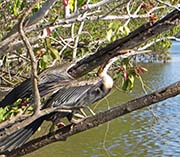African Darter - Anhinga rufa
| Length | |
| Wingspan | |
| Weight | |
| Clutch Size | |
| Chicks at birth | |
| IUCN Conservation Status | |
Continents: |
The African Darter is one of four species of Darters or Anhingas. Besides the African Darter, there is the Anhinga (American Darter), the Australian Darter, and the Oriental or Indian Darter. They are frequently called "Snakebirds" because they swim low in the water with only their heads and necks above the water and thus look like snakes. (This behavior is shown in one of my pictures on the American "Anhinga".) They are able to partially submerge because they have less buoyancy due to dense bones and feathers that hold onto the water. They dry out their feathers by spreading them out.
The male and female African Darters are sexually dimorphic. The male African Darters' plumage is mostly black and dark brown with white or grey streaking on the wings and a white stripe down the neck. Females are more brown and their neck is a beautiful chestnut. Both sexes have long thin necks, long thin pointed bills (the male bill is larger) and long tails. Their eyes have a yellow iris and a yellow or brown orbital ring. Juvenile plumage is similar to the females.
Even though the African Darter is declining, it is listed as a "Least Concern" bird because they inhabit most of Africa.
Diet: African Darters' use they bill to spear their prey such as fish and other aquatic animals such as snakes, frogs, crustaceans, etc. After diving for food, they will dry their feathers by spreading their wings.
Courtship: Breeding in Africa is believed to breed mostly at the end of the rainy season or during the dry season. They will pair bond for a season. One of the ways a male will attract a female is by raising his wings and then waving them. He will also bow and snap his bill and present twigs to potential mates.
Nesting: African Darters nest communally with other Darters and alongside cormorants, ibises, herons and egrets. Their nests are made from twigs and lined with leaves and are usually built near water in trees or reeds. They use their feet to keep the eggs warm since they don't have a brood patch. Usually 2-6 eggs are laid asynchronously. This means that when there is inadequate food, the younger chicks are unlikely to survive. Newly hatched chicks are fed partly digested regurgitated food.
Habitat and Range: The African Darter lives in sub-Saharan Africa. They prefer fresh water lakes, rivers, marshes, swamps, etc.
Vocalization: They vocalize with clicking or rattling sounds when flying or perching. In the nesting colonies, adults communicate with croaks, grunts or rattles. During breeding, adults sometimes give a caw or sighing or hissing calls.
Plumage/Molt There plumage or feathers do not change during breeding but their gular sac changes color from pink or yellow to black. Also, their yellow or yellow-green bare facial skin turns turquoise.
Migration: They seem to be mostly a non-migratory bird but they may do local migrations. For example, in Kenya, they will do frequent local migrations in response to rainfall patterns across the country.
Tongue/feet: Legs and feet are grey or brown. This varies with the season and the area. I am not sure if they have the same "mushroom shaped" tongue that Cormorants have.
Bibliography:
- http://en.wikipedia.org The Free Encyclopedia, Accessed June, 2012
- http://www.kenyabirds.org.uk/ Kenya Birds, Accessed June, 2012
- http://www.birds.cornell.edu The Cornell Lab of Ornithology, Accessed June, 2012
- Nelson, J. Bryan, Pelicans, Cormorants and their relatives,Oxford University Press, 2005




